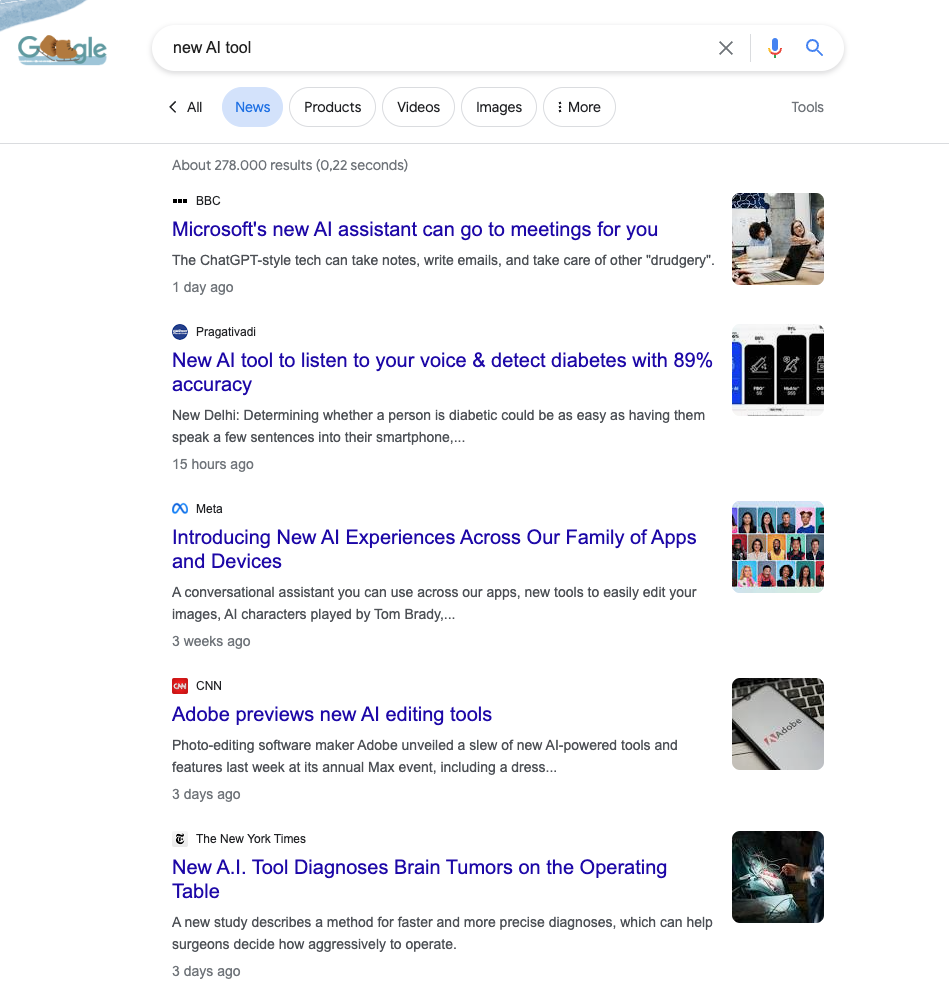Every time I look at the news or browse social media there is a post about a new, revolutionizing AI tool that a company is launching. AI is powerful and can transform industries completely, there is no doubt on that. But are all these AI tools adding to value to these companies’ strategies or are they just scared of falling behind the curve?
I google “New AI Tool” into google news just to prove a point and it resulted in 278K results with the first page full of companies launching their new AI tool.

Fear of Missing out (FOMO)
The fear of missing out on the AI revolution is real. No company wants to be left in the dust while competitors harness AI to gain a competitive edge. This fear drives the rapid adoption of AI tools, often without a clear understanding of how they fit into the overall strategy.
We need strategic changes.
For AI to truly deliver value, it must be integrated into a well-thought-out strategy(Kiron & Schrage, 2019). A company’s AI initiatives should align with its long-term goals and core competencies. It’s not just about having the latest AI tool; it’s about using it in a way that genuinely enhances your business(Kiron & Schrage, 2019).
To avoid AI fatigue, companies must continually measure the impact of these tools(Meier, 2020). Are they saving time, increasing revenue, improving customer satisfaction, or enhancing products? If the answer is yes, then the AI tools are doing what they’re supposed to do.
While AI fatigue is a real concern, the key, in my opinion, is reach to a balance between embracing the AI revolution and staying grounded in strategic thinking. AI tools can be transformative, but their value lies in how they are employed. Companies should be more critical in the launch of AI tools. By aligning AI with their goals, businesses can ensure that the AI tools they embrace truly contribute to their success. In this way, AI can be a game-changer, not just another buzzword.
Kiron, D., & Schrage, M. (2019, June 11). Strategy For and With AI. https://sloanreview.mit.edu/article/strategy-for-and-with-ai/
Meier, S. (2020, August 3). Measuring the business impact of artificial intelligence in customer service. KUNGFU.AI. https://medium.com/kung-fu/measuring-the-business-impact-of-artificial-intelligence-in-customer-service-697655acb701


Hi, I think it is interesting to see how companies actually align their goals with the use of AI. Next to specific for example revenue based goals, there are also requirements that are hard to measure. I don’t think it is actually possible for AI to measure for example the importance of continuation of a family business. I might be wrong and maybe the future will prove me wrong but I think that AI won’t be able to align with all the corporates’ goals.
I fully agree that some people and companies should take a step back and look at the bigger strategic picture, and frankly, it is something that I kind of needed to hear. I think it’s great that we are encouraged to be on top of the latest and greatest AI use cases and tools, but I feel like that has made me lose perspective a little.
AI has the potential to create so much value, and I understand that everybody is trying to capture it as fast as possible to gain an advantage over the competition, but after reading this I’ve come to realize again that the real value will likely be created by those who apply AI close to their core strategy in the medium to long term. Thanks for posting!
I agree with you that companies in pursuit of being ahead of competitors try to implement all sorts of AI tools. It’s also interesting to consider that these terms/tools are being used as buzz words in the industry now, as sort of a signalling device to external parties of the technologies that they are able to adopt.
I also was reading another comment on this post by Mark, in terms of losing perspective. This made me reflect on my stance regarding how companies convey that they may be using AI tools. I find that there seems to be a lot of noise of how certain implementations actually generate value for the company’s strategy and I agree that there needs to be a more critical stance on what is being adopted.
Insightful post, Mariana!
I strongly agree with your point that generative AI tools have started to be proven very valuable in certain contexts. Such as for example in the case of McKinsey. They started using their own in-house ChatGPT tool to help employees find relevant company data in a quicker way. But at the same time, it is true that many companies are quickly implementing generative AI tools without really knowing the possible future value they will provide. It is in many cases simply seen as an investment that has to be done since everybody is looking in the same direction, as you very well proved. Normally pushed by FOMO.
To further support your point I found it interesting to talk about the famous Gartner Hype cycle we talked about in class. On the official website of Gartner it can be seen that for 2023, generative AI is considered an emerging technology situated in the “Peak of Inflated Expectations”. This means that overall there’s a significant excitement and high future expectations surrounding the technology. I personally think that the quick adoption of generative AI by companies is mainly led by the FOMO concept you were commenting on and also the period of inflated expectations that every emerging technology experiments.
In sum, generative AI encounters itself in a period of unrealistic beliefs, since now it’s situated in a moment of overenthusiasm and overestimation of capabilities. This period normally transitions into a “trough Disillusionment”. It will be interesting to check in the future if the Gartner Hype Cycle was right.